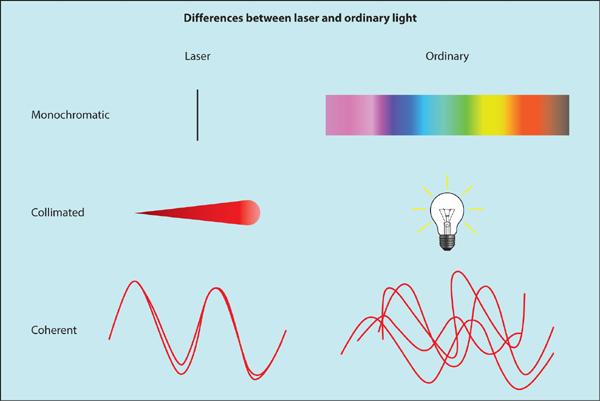FIGURE 20–1 The form of monochromatic light emitted from low-level lasers falls within red visible wavelength and infrared laser on the electromagnetic spectrum, between 600 and 1200 nm.
FIGURE 20–2 Laser is characterized by three distinct properties that make it different from conventional light.
The most common low-level lasers include those created by helium neon, gallium arsenide, and gallium aluminum arsenide. The differences between these three types of lasers are listed in TABLE 20-1.
TABLE 20-1 Comparison Between Common Low-Level Lasers14

The theory of low-level laser therapy is explained by a process called photobiomodulation. Photobiomodulation and other terminology used to discuss laser therapy are defined in TABLE 20-2. The light emitted by low-level lasers can penetrate the dermis and interact with many chromophores in the human tissues. This interaction can either stimulate or inhibit biological processes within these tissues, and therefore may positively impact wound healing. Some of the biological processes that appear to be affected by photobiomodulation include increased fibroblast proliferation, macrophage activity, collagen synthesis, and oxygen availability to tissues.9–13
TABLE 20-2 Low-Level Laser Terminology1,8,14

EFFECTS AT THE CELLULAR AND TISSUE LEVELS
Low-level laser therapy is thought to impact wound healing at a cellular level by reducing the number of cellular enzymes and chemicals associated with pain and inflammation. LLLT is also thought to stimulate the production of enzymes that enhance cell proliferation and cell division. Research has shown that LLLT stimulates macrophage activity, causing an increase in the release of chemical mediators involved with fibroblast production.4,14 In addition, studies have shown an increase in collagen synthesis in human tissues after treatment with LLLT.8,15 One study demonstrated an increase in the ability of oxygen to disassociate from hemoglobin, thus making the oxygen more available for transfer to hypoxic tissues, when treated with LLLT.8 In addition to these positive effects on wound healing, research has also supported the use of LLLT to affect human biological processes such as muscle cell proliferation, ATP synthesis, and immune system function.8,16–18
INDICATIONS, PRECAUTIONS, CONTRAINDICATIONS, AND ADVERSE REACTIONS
Without FDA approval for wound healing, clinicians must rely on existing research to determine appropriate indications for low-level laser therapy. These indications may include recalcitrant wounds, necrotic wounds, and infected or colonized acute or chronic wounds. Although no adverse reactions to LLLT have been reported, the following precautions and contraindications are advised:
 During the first trimester of pregnancy
During the first trimester of pregnancy
 Over cancerous growths
Over cancerous growths
 Over thyroid tissue
Over thyroid tissue
 Direct exposure to the eyes (could result in a retinal burn)
Direct exposure to the eyes (could result in a retinal burn)
PARAMETERS AND TECHNIQUES FOR APPLICATION
Parameters
Treatment parameters for low-level laser therapy depend on the type of laser used and the dosage delivered. Research supports the use of helium neon and gallium arsenide lasers to promote wound healing at doses between 4 and 10 J/cm2. Most LLLT devices offer a preset exposure time in seconds. In general, the higher the intensity in which the laser is delivered, the less the time needed to treat a given surface area. Dosages delivered greater than 500 mW or extended treatment times can cause harm to healthy tissues; therefore, low-level laser treatments should be delivered no more than once a day.
Techniques for Application
Clinical application of low-level laser therapy requires that both the patient and the clinician wear eye protection, for example, laser protection goggles as shown in FIGURE 20-3. The laser equipment is cleansed prior to and after treatment per the manufacturer’s guidelines. After cleansing the wound and removing debris when indicated, the wound is covered with a transparent film, overlapping the wound edges by ½ inch, and pressing the film into the base of the wound cavity if the wound has depth. Laser can penetrate transparent films; therefore, the patient is positioned comfortably maximizing exposure of the wound to allow the laser probe to come into direct contact with the transparent film covering the wound as shown in FIGURE 20-4.14 The laser probe is placed in direct contact with the transparent film and maintains direct contact throughout the treatment. The tissue is irradiated per manufacturer’s guidelines. The laser device is held in one position during the treatment and sweeping motions are avoided to optimize absorption of the light energy. When the wound is larger than the laser probe, the probe is moved to the untreated areas and the technique is repeated until all targeted tissue has been irradiated. An alternative treatment technique involves moving the laser probe continuously from one treatment area
Stay updated, free articles. Join our Telegram channel

Full access? Get Clinical Tree







